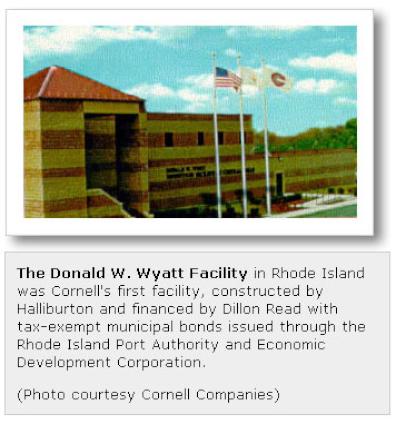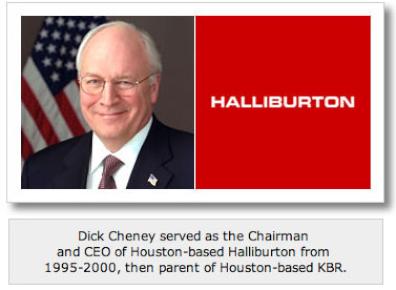Dillon Read (10): Cornell Corrections
A Serialised Story - Part 10 of 20 (publishing August/September 2007)
Dillon Read & Co. Inc.
And the Aristocracy of Stock
Profits
By Catherine Austin
Fitts
Click Here For Links To Other
Chapters
http://www.scoop.co.nz/stories/HL0708/S00302.htm#2
Chapter 9: Cornell Corrections
Based on company SEC filings, Houston-based Cornell Corrections started off with correctional facilities in Massachusetts and Rhode Island in 1991 and then in 1994 acquired Eclectic Communications, the operator of 11 pre-release facilities in California with an aggregate design capacity of 979 beds. An important relationship for Cornell from the start was the U.S. Marshals Service, an agency of DOJ, who was Cornell’s primary client for its Donald W. Wyatt Federal Detention Facility in Central Falls, Rhode Island, a facility with a capacity of 302 beds.

The U.S. Marshals Service is the oldest U.S. enforcement agency. Among other duties, the U.S. Marshals Service houses and transports prisoners prior to sentencing and provides protection for the federal court system. According to the Marshals Service’s website, they are also:
“Responsible for managing and disposing seized and forfeited properties acquired by criminals through illegal activities. Under the auspices of the Department of Justice Asset Forfeiture Program, the Marshals Service currently manages more than $964 million worth of property, and it promptly disposes of assets seized by all DOJ agencies. The goal of the program is to maximize the net return from seized property and then to use the property and proceeds for law enforcement purposes.”

An article by Jeff Gerth and Stephen Labaton in the New York Times in November 1995, 'Prisons for Profit: A Special Report; Jail Business Shows Its Weaknesses" describes the problems that Cornell ran into with its Rhode Island facility. This facility had been financed with municipal bonds issued through the Rhode Island Port Authority in the summer of 1992 and underwritten by Dillon Read. The article states:
********** “Two years ago, the owners of the red cinder-block prison in this poor mill town threw a lavish party to celebrate the prison's opening and show off its computer monitoring system, its modern cells holding 300 beds and a newly hired cadre of guards.
“But one important element was in short supply: Federal prisoners.
“It was more than an embarrassing detail. The new prison, the Donald W. Wyatt Detention Facility, is run by a private company and financed by investors. The Federal Government had agreed to pay the prison $83 a day for each prisoner it housed. Without a full complement of inmates, it could not hope to survive.
“So the prison's financial backers began a sweeping lobbying effort to divert inmates from other institutions. Rhode Island's political leaders pressed Vice President Al Gore while he was visiting the state as well as top officials at the Justice Department to send more prisoners. Facing angry bondholders and insolvency, the company, Cornell Corrections, also turned to a lawyer who was then brokering prisoners for privately run institutions in search of inmates.
“The lawyer, Richard Crane, has done legal work for private corrections companies and Government penal agencies. He put the Wyatt managers in touch with North Carolina officials. Soon afterward, 232 prisoners were moved to Rhode Island from North Carolina, and Mr. Crane was paid an undisclosed sum by Cornell Corrections.”
**********

Cornell’s Donald C. Wyatt facility later became a case study at the Harvard Design School’s Center for Design Informatics. This was an indication of the wave of business and investment opportunities that prisons and enforcement presented to everyone from architects to construction companies to real estate and tax-exempt bond investors.[42] Harvard’s case study mentions that Cornell arranged for the facility to be constructed by Brown & Root of Houston, Texas, then a subsidiary of Halliburton. (Brown & Root, now known as KBR, separated from Halliburton in April 2007 after 44 years as a subsidiary.) Brown & Root/KBR's construction of prison facilities was to become more visible many years later after its construction of detention facilities at Guantanamo Bay, prisoner of war camps in Iraq and its winning of contracts to build detention centers for the Department of Homeland Security. A request to Cornell for information regarding companies used for prison construction subsequent to the Wyatt facility has been made, but no response has yet been received.
Dillon Read had long standing relationships with Brown & Root and the Houston banking and business leadership as a result of the firm's historical role in underwriting oil and gas companies, including pipelines. In 1947, Herman and George Brown, the founders and owners of Brown & Root, were part of a group of Texas businessmen banked by Dillon Read as investor and underwriter (in a manner very similar to Dillon's backing of Houston-based Cornell many years later) to form the Texas Eastern Transmission Co. to buy the "Big Inch" and "Little Big Inch" pipelines in a privatization by the U.S. government.
The Texas Eastern pipelines were critical to bringing natural gas from Texas and the Southwest to Eastern markets. For most Americans, Houston and New York seem far apart. However, the intimacy of their connection is better understood when you study the investment syndicates that controlled the railroad, canals, pipelines and other transportation systems that have connected these markets and helped to determine control of the local retail businesses for both goods and capital along the way. For example, Texas Eastern's Big Inch pipeline went from east Texas to Linden, New Jersey, some 30 miles away from the Dillon and Brady estates in New Jersey and approximately 20 miles from the Dillon Read offices on Wall Street.
According to investigative journalist Dan Briody in The Halliburton Agenda: The Politics of Oil and Money, the Brown brothers netted $2.7 million in profits on their shares in their initial public offering right after the company was formed and won the bid to buy the pipelines from the government in the late 1940's. That, however, was not the real payoff. According to Briody, Brown & Root subsequently worked on 88 different jobs for Texas Eastern, and generated revenues of $1.3 billion from Texas Eastern between 1947 and 1984. [42.1]
According to Robert Sobel in The Life and Times of Dillon Read, under August Belmont's personal leadership of the transaction, Dillon Read also made a profit on the Texas Eastern shares. "Nothing is known of Dillon Read's profits on the underwriting, but it was a sizeable owner of TETCO [Texas Eastern] common, acquired at 14 cents a share, which rose to $9.50." [42.2] While figures for Dillon Read revenues from underwriting and other investment banking services over the years comparable to Brown & Root's construction contracts are not available, my recollection was that Dillon continued to maintain a profitable relationship with Texas Eastern when I worked at the firm in the 1980s many decades later. Interestingly enough, Briody also describes in detail the McCarthyist efforts that were made to destroy Federal Power Commission chairman Leland Olds, an honest government official, because his ethical regulatory decisions threatened the richness of the Texas Eastern profits. The clear implication is that the pattern of generating financial windfalls from government privatizations combined with dirty tricks against honest government officials is nothing new. [42.3]
The closeness of the Brown & Root relationship with Dillon Read is also underscored by Briody's description of the head of Brown & Root’s frustration with Lyndon Johnson's decision to serve as John Kennedy's running mate. He quotes August Belmont, by then a leader of Dillon Read, who was with Brown in Houston in his private hotel suite listening to the radio coverage of Johnson's announcement. According to Belmont, "Herman Brown....jumped up from his seat and said, 'Who told him he could do that?' and ran out of the room." [42.4]
What Briody does not mention is allegations regarding Brown & Root's involvement in narcotics trafficking. Former LAPD narcotics investigator Mike Ruppert once described his break up with fiancé Teddy — an agent dealing narcotics and weapons for the CIA while working with Brown & Root, as follows:
********** “Arriving in New Orleans in early July, 1977 I found her living in an apartment across the river in Gretna. Equipped with scrambler phones, night vision devices and working from sealed communiqués delivered by naval and air force personnel from nearby Belle Chasse Naval Air Station, Teddy was involved in something truly ugly. She was arranging for large quantities of weapons to be loaded onto ships leaving for Iran. At the same time she was working with Mafia associates of New Orleans Mafia boss Carlos Marcello to coordinate the movement of service boats that were bringing large quantities of heroin into the city. The boats arrived at Marcello controlled docks, unmolested by even the New Orleans police she introduced me to, along with divers, military men, former Green Berets and CIA personnel.
“The service boats were retrieving the heroin from oil rigs in the Gulf of Mexico, oil rigs in international waters, oil rigs built and serviced by Brown and Root. The guns that Teddy monitored, apparently Vietnam era surplus AK 47s and M16s, were being loaded onto ships also owned or leased by Brown and Root. And more than once during the eight days I spent in New Orleans I met and ate at restaurants with Brown and Root employees who were boarding those ships and leaving for Iran within days. Once, while leaving a bar and apparently having asked the wrong question, I was shot at in an attempt to scare me off.”[43]
Source: "Halliburton’s Brown and Root is One of the Major Components of the Bush-Cheney Drug Empire" by Michael Ruppert, From the Wilderness
**********
Another important relationship for the Houston-based Cornell Corrections was the California Department of Corrections. Whether this reflected that California was home base for David Cornell’s former employer, Bechtel, is not clear. When Cornell Corrections got started, California had the largest prison population of any U.S. governmental entity. In part due to extraordinary growth in incarcerations of non-violent drug users as a result of the War on Drugs, the federal prison population managed by the Federal Bureau of Prisons at the Department of Justice has become the largest with 186,560 based on their September 8, 2005 weekly update.[44] California is close behind with 168,000 youths and adults incarcerated in California prisons and 116,000 subject to parole.

Cornell’s early years of business were not financially profitable. The private prison industry faced significant resistance and legal and operational challenges to privatizing federal, state and local prison capacity. Within the private prison industry, Cornell faced competition for new contracts and acquisitions from two larger, more experienced companies, CCA and Wackenhut. By 1995, compared to industry leaders, Florida-based Wackenhut and Tennessee based Corrections Corporation of America (CCA), Cornell Corrections appeared to be lagging in government contract growth. As of mid 1996, Cornell was carrying $8 million of cumulative losses on its balance sheet.
Cornell’s Chief Financial Officer, Treasurer and Secretary was Steven W. Logan, who had served as an experienced manager in Arthur Anderson’s Houston office. This was the same office of Arthur Anderson that had served as Enron’s auditor until the Enron bankruptcy brought about the indictment and conviction of Arthur Andersen.[45] Arthur Andersen was Cornell’s auditor, having first served as a consultant to create market studies which helped support the approvals for and financing of the building of the Rhode Island facility for the U.S. Marshals Service. Logan was later forced out of Cornell after an off-balance sheet deal[46]engineered with the help of a former Dillon Read banker Joseph H. Torrence, like those done for Enron was called into question and significant stock value declines triggered litigation from shareholders.
|
| 1992 | 1993 | 1994 | 1995 | 1996 |
| Revenues | $2.5MM | $3.2MM | $15.7MM | $20.6MM | $32.3MM |
| Net Income (Loss) | .9 | (.9) | (.6) | (1.0) | (2.4) |
| Beds in Operation | - | 282 | 1,155 | 1,135 | 2,899 |
| (MM = In
millions) | |||||
Most venture capital investors prefer to exit their investment within 5 years. That means that Dillon Read would have likely wanted to establish or start their exit from Cornell by 1996. The stock market was hungry for Initial Pubic Offerings (IPOs) where a new company sells its stock to the public for the first time. Venture capitalists typically make their profit from financing a company and then selling their equity when a public market can been established for the company’s stock. However, by the end of 1995, Cornell’s story was not an exciting one. It was not a market leader, its growth was slow and it had no profits. If the calf was going to be taken to market, it would need fattening.
A Note on “Prison
Pop”
The “pop” is a word I learned on Wall Street to describe the multiple of income at which a stock is valued by the stock market. So if a stock like Cornell Corrections trades at 15 times its income, that means for every $1 million of net income it makes, it's stock goes up $15 million. The company may make $1 million, but its “pop” is $15 million. Folks make money in the stock market from the stock going up. On Wall Street, it's all about “pop.”
Prison stocks also are valued on a “per bed” basis — which is based on the number of beds provided and the profit per bed. “Per bed” is really a euphemism for people who are sentenced to be housed in their prison.
For example, in 1996, when Cornell went public, based on the financial information provided in the offering document provided to investors, its stock was valued at $24,241 per bed. This means that for every contract Cornell got to house one prisoner, at that time, their stock went up in value by an average of $24,261. According to prevailing business school philosophy, this is the stock market’s current present value of the future flow of profit flows generated through the management of each prisoner. This, for example, is why longer mandatory sentences are worth so much to private prison stocks. A prisoner in jail for twenty years has a twenty-year cash flow associated with his incarceration, as opposed to one with a shorter sentence or one eligible for an early parole.[47] This means that we have created a significant number of private interests — investment firms, banks, attorneys, auditors, architects, construction firms, real estate developers, bankers, academics, investors among them— who have a vested interest in increasing the prison population and keeping people behind bars as long as possible.
When you invest in stock, you make money if and when you sell the stock at a higher price than you paid for it. This would be true for the people who invested in Cornell stock, including Dillon Read and its venture funds. Cornell was run by a board of directors that represented the shareholders, particularly the controlling shareholders — in this case Dillon Read. The board is the group of people who decides what goes. Senior management officials, such as the founder and Chairman David Cornell, who run the company day to day, are also on the board. Most of the money they make comes from stock options that they get to encourage them to get the stock to go up for the investors. That means that what everyone who runs the company wants is for the stock to go up.
There are two ways to make the stock go up. First, you can increase net income by increasing capacity — the number of “beds” — or profitability — “profits per bed.” Second, you can increase the multiple at which the stock trades by increasing the markets’ expectations of how many beds or what your profit per bed will be and by being very accessible to the widest group of investors. So, for example, passing laws regarding mandatory sentencing or other rules that will increase the needs for prison capacity can increase the value of private prison company stock without those companies getting additional contracts or business. The passage of — or anticipation of — a law that will increase the demand for private prisons is a “stock play” in and of itself.
The winner in the global corporate game is the guy who has the most income running through the highest multiple stocks. He is the winning “pop player.” Like the guy who wins at monopoly because he buys up all the properties on the board, he can buy up the other companies. So the private prison company that wins is the one that gets the most contracts that guarantee it the most prisons and prisoners that generate the most income for the longest period with the smallest amount of risk.
The way that Cornell could become a winner quickly was to get lots of government contracts to house lots of prisoners and acquire other companies with government contracts to house lots of prisoners and do it quickly.[48] And that was exactly what happened.
FOOTNOTES[42] See Harvard Design School Case Study (http://www.dunwalke.com/resources/documents/Events/ Harvard_Case_Study_940101-014.pdf).
[42.1] See The Halliburton Agenda: The Politics of Oil and Money, Dan Briody, John Wiley & Sons, 2004, pages 103 and 112 (http://www.powells.com/s?kw=halliburton+agenda&x=0&y=0).
[42.2] See The Life and Times of Dillon Read, Robert Sobel, Penguin Books, 1991, page 234.
[42.3] See The Halliburton Agenda: The Politics of Oil and Money, Dan Briody, John Wiley & Sons, 2004, Chapter 5: Collateral Damage: The Leland Olds Story, pages 93-114.
[42.4] See The Halliburton Agenda: The Politics of Oil and Money, Dan Briody, John Wiley & Sons, 2004, page 150 For description of Suite 8f (Brown’s private hotel suite) and the “Suite 8F Crowd,” see pages 132-141.
[43] See Halliburton’s Brown and Root is One of the Major Components of the Bush-Cheney Drug Empire by Michael Ruppert (http://www.fromthewilderness.com/free/ciadrugs/bush-cheney-drugs.html). See also, Opening Remarks of Michael Ruppert for the Senate Select Intelligence Committee (http://www.fromthewilderness.com/ssci.shtml).
See Brown and Root entry from Wikipedia (http://en.wikipedia.org/wiki/Kellogg,_Brown_and_Root).
See Halliburton entry from Wikipedia (http://en.wikipedia.org/wiki/Halliburton).
[44] See Federal Bureau of Prisons Weekly Report (http://www.bop.gov/news/weekly_report.jsp#bop).
[45] See Anderson Guilty (http://www.solariactionnetwork.com/phpBB2/viewtopic.php?p=9515#9515).
[46] See Charity Lends a Hand to Prisons With Murky Off-the-Books Deals by Joseph T. Hallinan (Wall Street Journal, May 1, 2002) (http://www.prisonsucks.com/scans/prisonaccounting.shtml).
[47] Allegations have been made that the prison system works on a bonding system that bonds each prisoner. The author does not know if such a system exists and, if it does exist, how it works.
[48] For more on public subsidies for private prisons see Jail Breaks, Economic Subsidies Given to Private Prisons (http://www.goodjobsfirst.org/pdf/jailbreaks.pdf or http://www.soros.org/initiatives/justice/ articles_publications/publications/jailbreaks_20011001) and The Real Costs of Prison Project (http://realcostofprisons.org/).
 Mapping The Real Deal is a column on
Scoop supervised by Catherine Austin Fitts. Ms Fitts is the
President of Solari, Inc. http://www.solari.com/. Ms. Fitts is
the former Assistant Secretary of Housing-Federal Housing
Commissioner during the first Bush Administration, a former
managing director and member of the board of directors of
Dillon Read & Co. Inc. and President of The Hamilton
Securities Group,
Inc.
Mapping The Real Deal is a column on
Scoop supervised by Catherine Austin Fitts. Ms Fitts is the
President of Solari, Inc. http://www.solari.com/. Ms. Fitts is
the former Assistant Secretary of Housing-Federal Housing
Commissioner during the first Bush Administration, a former
managing director and member of the board of directors of
Dillon Read & Co. Inc. and President of The Hamilton
Securities Group,
Inc.


 Keith Rankin: Geopolitical Fractures, And Untidy Yet Workable Solutions
Keith Rankin: Geopolitical Fractures, And Untidy Yet Workable Solutions Gordon Campbell: On Winston Peters’ Battle Against The Phantom Legions Of The Woke
Gordon Campbell: On Winston Peters’ Battle Against The Phantom Legions Of The Woke Adrian Maidment: Road Cone Final Exam & Donald, I Warned You!
Adrian Maidment: Road Cone Final Exam & Donald, I Warned You! Binoy Kampmark: The Script Of Anxiety - Poland’s Nuclear Weapons Fascination
Binoy Kampmark: The Script Of Anxiety - Poland’s Nuclear Weapons Fascination Martin LeFevre - Meditations: Regarding Randomness And Significance
Martin LeFevre - Meditations: Regarding Randomness And Significance Ian Powell: When Apartheid Met Zionism
Ian Powell: When Apartheid Met Zionism